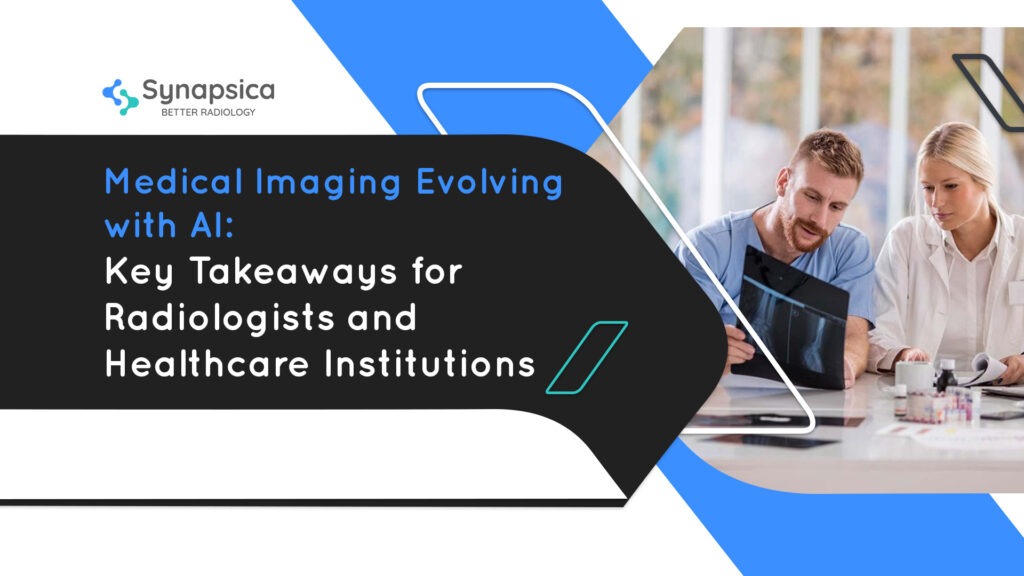
The applications of AI in medical imaging are increasing significantly. From image acquisition to report generation, AI is simplifying the jobs of healthcare professionals who primarily work with medical images.
Healthcare institutions are becoming increasingly dependent on imaging procedures for diagnosis and prognosis. Over 70 million CT scans are performed in the U.S. every year. Nearly 1 million imaging exams are performed worldwide every year for mammography. 90% of healthcare data are medical images.
While the use of medical imaging has increased exponentially over the years, healthcare professionals, particularly radiologists and pathologists who are trained to discern diseases from images are plummeting.
With a tidal wave of medical images hitting the healthcare institutions, radiologists who used to read 3 MRIs per day a decade ago are now reading 12 per day. And the numbers vary as per the imaging modality. On average, a radiologist will read anywhere between 20 to 100 scans a day, where every scan might have hundreds to thousands of images to review.
In this article, we are going to discuss:
-
Early and accurate diagnosis of diseases with AI
-
Quick and quantitative analysis of medical images with AI
-
AI-enabled precision medicine
With radiologists leading the list, every healthcare professional is experiencing burnout to a different degree, given the nature of their work. Among healthcare innovations like 3-D printed devices, biosensors and trackers, telehealth, and next-generation sequencing, Artificial intelligence or AI has stolen the show with its capability to turn machines into humans and superhumans.
Download Now: How AI Can Help in Spine MRI Reporting?
Here are the key takeaways for radiologists and healthcare institutions for the coming decade, where AI will be the new face of medical imaging.
1. Early and accurate diagnosis of diseases
Delayed diagnosis, incorrect diagnosis, and failure to diagnose have been the most common accusations for medical malpractice claims.
While timely and appropriate diagnosis is in itself a challenge, given the siloed working nature of the healthcare professionals, which is mostly the outcome of the gaps in healthcare infrastructure, early diagnosis of most diseases, particularly spine problems and cancer has been an unachievable goal until the advent of AI.
Breast cancer, which is the second most common cancer among the female population, is missed in 1 in 5 cases during a conventional mammogram screening. Spine problems which are on the verge of becoming the globe’s next endemic are hard to diagnose at an early stage, given the subjective nature of the diagnosis.
AI can help in accurate and early diagnosis of diseases. As published in The American Journal of Surgical Pathology, Google’s AI-powered Lymph Node Assistant (LYNA) can identify breast cancer metastasis with 99% accuracy, which is missed by human pathologists nearly 62% of the time.
2. Quick and quantitative analysis of medical images
Often the root cause for untimely or incorrect diagnosis is the subjective nature of diagnostic radiology and reporting. With the global scarcity of radiologists increasing at an awful speed, it is highly unlikely for radiologists to read images and quantitatively report the findings, particularly when they barely get 3 to 4 seconds to study an image.
With AI, machines can learn and act as robot radiologists who can perform tasks of radiologists efficiently and exhaustively. AI can help in measuring the various elements of body parts, cross-compare the findings with conventional values, and report the findings with the appropriate degree of severity, reducing the chances for inter-observer variability and misdiagnosis.
Though AI applications have been widely used in cancer detection and drug discovery up until now, numerous health tech firms and AI enthusiasts are focusing on leveraging AI’s potential on other health problems like heart diseases, spine problems, etc.
For instance, Spindle – an AI assistant for spine MRIs, enables early and accurate diagnosis of spine problems by quantitatively analyzing deformities in the spine. Spindle quantifies and characterizes features of disc shape, grades disc degeneration, detects signal intensity changes, classifies pathology in objective grades, etc., and generates objective reports in just a click.
3. Enable precision medicine
While different people can suffer from the same disease, it isn’t necessary that the same course of treatment might suit everyone or that everyone will have the same recovery period. The human body is a unique system and it functions differently as per a person’s genetics, lifestyle, environment, and geography.
Precision medicine is becoming the ultimatum for healthcare providers. Precision medicine proposes the customization of healthcare services based on a patient’s genetics, geography, and lifestyle. As opposed to a one-size-fits-all approach, precision medicine allows physicians and researchers to prognosis treatment and build prevention strategies for particular diseases.
AI in medical imaging can help in enabling and advancing precision medicine. Researchers from Stanford University found out that machine learning can help in accurately identifying and grading lung cancer, and predict patient survival rates better than pathologists.
Future of medical imaging with AI
AI is already taking medical imaging to the next level. Until a couple of years back, the applications of AI in radiology were limited to cancer. But today, AI is used for various other purposes like detecting cardiovascular abnormalities, identifying fractures/other musculoskeletal injuries in the spine, diagnosing neurological illness and thoracic conditions, predicting post-operative care complications, etc.
The mounting pressure on radiologists due to the rapidly decreasing radiologist population and the increasing demand for timely and accurate diagnosis has wreaked havoc on the efficiency of radiologists. However, with AI reshaping radiology and medical imaging, radiologists can work more efficiently regardless of the heavy workload and healthcare institutions can be less concerned about the increasing global shortage of physicians and radiologists.
Check out how Synapsica’s AI-driven PACS software, RADIOLens, and spine reporting tools, Spindle and SpindleX, are reducing TAT and reporting errors for radiologists in this free demo (Link).
